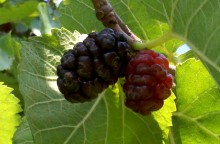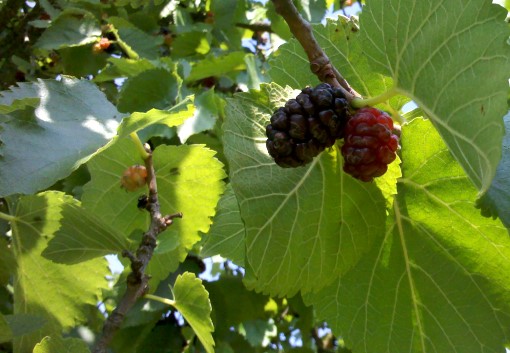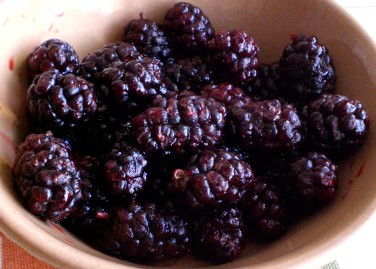Mulberries
By Mike on Wednesday, August 3, 2011, 15:16 - Permalink
 This is urban foraging, rather than true wild food, but it's still a great free food resource - Mulberries. Find some of these, and you're in for a real treat.
This is urban foraging, rather than true wild food, but it's still a great free food resource - Mulberries. Find some of these, and you're in for a real treat.
What Are Mulberries?
 Morus spp - In this case, M. nigra - the black mulberry - which happens to be one of the best species for edible fruit, bearing heavy crops of large blackberry-like juicy, aromatic fruits.
Morus spp - In this case, M. nigra - the black mulberry - which happens to be one of the best species for edible fruit, bearing heavy crops of large blackberry-like juicy, aromatic fruits.
You may also find other species such as M. alba, which is interesting in that it is the staple food of silkworms, but unfortunately, the pale-coloured fruit of that species is said to be disappointingly insipid in flavour.
 The mulberry tree is robust, growing to a rounded conical shape. The leaves are large, fairly coarse and stiff, fresh green in colour and heart-shaped, with a raggedly toothed margin.
The mulberry tree is robust, growing to a rounded conical shape. The leaves are large, fairly coarse and stiff, fresh green in colour and heart-shaped, with a raggedly toothed margin.
They're often found as specimen trees in parks and public gardens - certainly no arboretum would be complete without one.

The fruits ripen from mid summer onwards, over quite an extended period - so at any one time, there could be overripe fruits falling off the tree, and small, hard, greenish fruits yet to develop and ripen.
This is a boon to the casual urban forager, as it means the crop is highly unlikely to vanish all at once under the assault of birds, or any human competitors.
 The fruits themselves are extremely juicy and delicate - tending to burst at even the gentlest touch - so that it is almost impossible to pick them without acquiring copious juice stains to the hands (and probably clothes).
The fruits themselves are extremely juicy and delicate - tending to burst at even the gentlest touch - so that it is almost impossible to pick them without acquiring copious juice stains to the hands (and probably clothes).
When completely ripe, they will fall from the tree of their own accord - indeed probably the most efficient way to pick them in any quantity is to spread a large plastic sheet on the ground and gently shake the branches - however, this may not be practical if the tree is in a public space.
 Their delicate nature is the reason these delicious fruits are seldom found for sale in the shops - but that commercial rarity makes them all the more special.
Their delicate nature is the reason these delicious fruits are seldom found for sale in the shops - but that commercial rarity makes them all the more special.
The flavour is sweet and aromatic, reminiscent of blackberries and raspberries, but with an exciting fizzy acidity and a fresh, surprising taste that I think resembles fresh figs (to which they are botanically related)
They look as though they ought to be very pippy, but this is not the case - they do have a few seeds inside, but they're crisp, not woody at all - like the seeds in a fig.
Mulberries make excellent jam, and I expect they would be delicious as juice or even wine, but my favourite way to enjoy them is fresh, straight from the tree in my lunch break in the park - returning to work with crimson juice stains on the cuffs of my shirt.
Urban Foraging
You don't need to trek out to the countryside to find interesting food for free - even in the city, there are tasty treats to be found - if you know what to look for...
Important
Urban Foraging does call for a slightly different approach from the norm - the forager must consider a few extra questions:
- Might there have been contamination by pesticide sprays, vehicle exhaust or industrial chemicals?
- Is it even permissible to be picking these, here?
- Can I do this without causing damage to anything (including damaging the aesthetics of display)?
Talking to the park keeper or landscaping staff might help to resolve these questions - I've tried this a number of times and have thus far always received a positive and helpful response - showing a genuine interest in the plants seems to be generally quite a good way to get on friendly terms with the folks who look after them.
